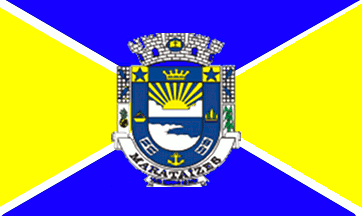 image by Dirk Schönberger,
27 March
2010
image by Dirk Schönberger,
27 March
2010
Last modified: 2012-02-11 by ian macdonald
Keywords: espírito santo | marataízes |
Links: FOTW homepage |
search |
disclaimer and copyright |
write us |
mirrors
 image by Dirk Schönberger,
27 March
2010
image by Dirk Schönberger,
27 March
2010
based on http://pt.wikipedia.org/wiki/Marata%C3%ADzes
Divided per saltire blue over yellow, fields fimbriated white; at center the municipal arms.
Official website at
http://www.marataizes.es.gov.br. The flag is described here:
http://www.marataizes.es.gov.br/default.asp. The flag is shown on Wikipedia
at
http://pt.wikipedia.org/wiki/Marata%C3%ADzes.
Dirk Schönberger,
27 March 2010
The municipality of Marataízes (36,494 inhabitants; 135 sq. km) is located in
coastal southern Espírito Santo, 130 km of Vitória.
Marataízes was
created by Law No. 4,619 of 14 January 1992, seceding from Tapemirim, and
inaugurated on 10 January 1997. The municipality is named for a Tupi-Guarani
word meaning "water running to the sea", probably referring to the numerous
lagunas connected to the ocean. Local legends relate the name of the
municipality to the death of a beloved woman named Ísis ("Mataram Ísis",
"Isis is dead"), or to the beach offered to Tais by his father ("Mar Taís", "Tais'
Sea"). Yet another legend says that the African slaves of Bantu origin spoke
Marata and venerated goddess Isis. Marataízes is the birth place of Domingos
Martins (1781-1817), the hero of the Pernambuco Revolution (see the municipality of Domingos Martins).
The municipal flag
of Marataízes was designed in 2006 after a public contest held between 19
June and 25 August 2006, prescribed by Decree No. 506 of 1 February 2006. The
flag was officially unveiled on 16 October 2006. The flag was designed by
Marataízes-born Renan do Nascimento Barboza (b. 1990). The designer used the
colors of the municipal coat of arms, blue, black, yellow and white. Blue
symbolizes the sky and the sea, serenity and highness. For the municipality,
blue symbolizes the sea and its resources and fishes, as well as river
Itapemirim, of economical and historical significance. Black symbolized life
in ancient Greece. For the municipality, black symbolizes progress through
tourism and oil industry. Yellow symbolizes gold and the soil, power and
God's kindness. For the municipality, yellow symbolizes its natural
resources, such as pine apples and sugar cane. White symbolizes peace,
calm and kindness. For the municipality, white represents the tranquility of
the beaches and the villages of the inner municipality.
The coat of
arms of Marataízes was designed in September 1997 by the heraldist Paulo
Sérgio Lettieri Martins, on the base of ideas supplied by Iracy do Nascimento
and Silva and Irandy A. de Faria. The Portuguese shape of the shield recalls
the Portuguese origin of Brazil. The stars represent the regional pioneers, Domingos de Freitas Bueno Caxangá and Pedro de Silveira, respectively. The
landscape elements placed in the border of the shield (commonly used in the
Brazilian heraldry) highlight the natural resources of the municipality and
tourism; a boat stands for the Canoeing Festival and the wavy stripes stand
for the lagunas; the feather headgear stands for the natives, especially the
Goytacazes (once dominant in the region); the golden anchor is the heraldic
symbol of trust, firmness and devotion to God; the crown represents the
national hero Domingos Martins.
The five-towered crown argent represents
the town. The book with the Holy Cross [placed on the mural crown],
established as the patron of the town, represent the Good Book ensigned with
the universal cross of the Christian religion. The date "14 janeiro 1992" (14
January 1992) is the date of municipal emancipation. The nets with the
fishes, the pineapple and the sugarcane represent the resources of the
municipality. Or mean strength, argent means candor, azure means beauty and
nobleness, and black means firmness and constancy.
Ivan Sache,
21 January 2012